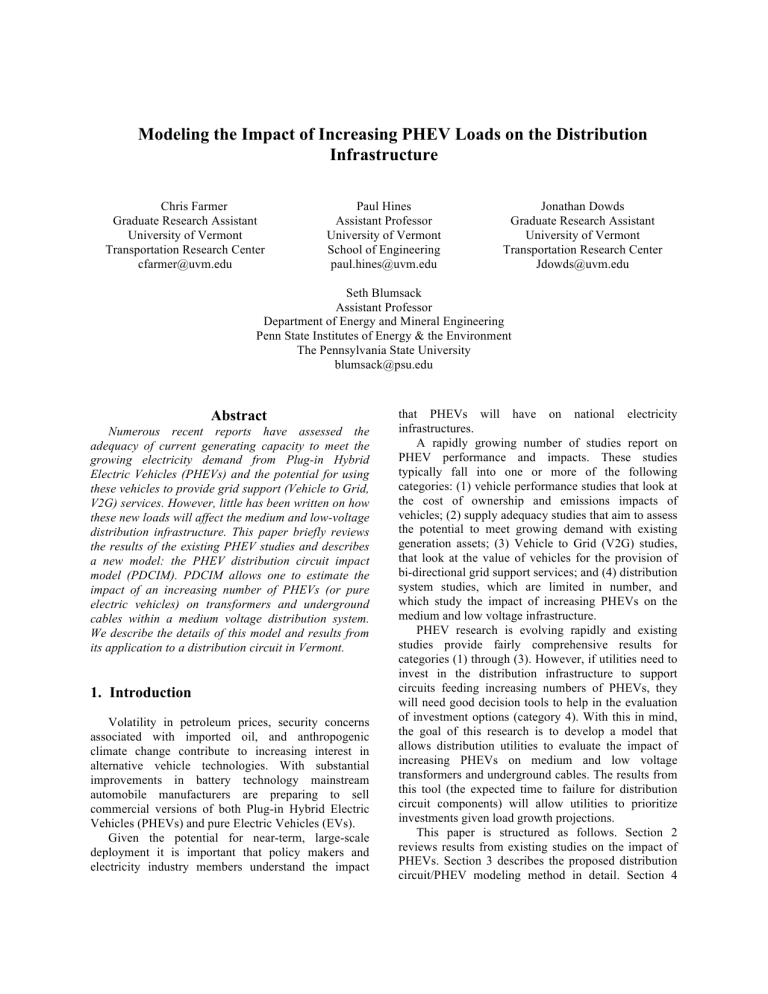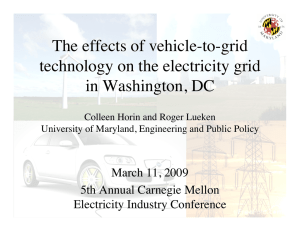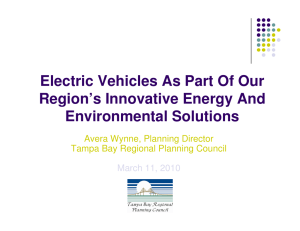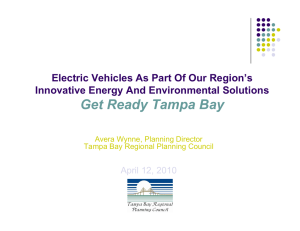Modeling the Impact of Increasing PHEV Loads on the Distribution

Modeling the Impact of Increasing PHEV Loads on the Distribution
Infrastructure
Chris Farmer
Graduate Research Assistant
Paul Hines
Assistant Professor
Jonathan Dowds
Graduate Research Assistant
University of Vermont
Transportation Research Center cfarmer@uvm.edu
University of Vermont
School of Engineering paul.hines@uvm.edu
Seth Blumsack
Assistant Professor
Department of Energy and Mineral Engineering
Penn State Institutes of Energy & the Environment
University of Vermont
Transportation Research Center
Jdowds@uvm.edu
The Pennsylvania State University blumsack@psu.edu
Abstract
Numerous recent reports have assessed the adequacy of current generating capacity to meet the growing electricity demand from Plug-in Hybrid
Electric Vehicles (PHEVs) and the potential for using these vehicles to provide grid support (Vehicle to Grid,
V2G) services. However, little has been written on how these new loads will affect the medium and low-voltage distribution infrastructure. This paper briefly reviews the results of the existing PHEV studies and describes a new model: the PHEV distribution circuit impact model (PDCIM). PDCIM allows one to estimate the impact of an increasing number of PHEVs (or pure electric vehicles) on transformers and underground cables within a medium voltage distribution system.
We describe the details of this model and results from its application to a distribution circuit in Vermont.
1.
Introduction
Volatility in petroleum prices, security concerns associated with imported oil, and anthropogenic climate change contribute to increasing interest in alternative vehicle technologies. With substantial improvements in battery technology mainstream automobile manufacturers are preparing to sell commercial versions of both Plug-in Hybrid Electric
Vehicles (PHEVs) and pure Electric Vehicles (EVs).
Given the potential for near-term, large-scale deployment it is important that policy makers and electricity industry members understand the impact that PHEVs will have on national electricity infrastructures.
A rapidly growing number of studies report on
PHEV performance and impacts. These studies typically fall into one or more of the following categories: (1) vehicle performance studies that look at the cost of ownership and emissions impacts of vehicles; (2) supply adequacy studies that aim to assess the potential to meet growing demand with existing generation assets; (3) Vehicle to Grid (V2G) studies, that look at the value of vehicles for the provision of bi-directional grid support services; and (4) distribution system studies, which are limited in number, and which study the impact of increasing PHEVs on the medium and low voltage infrastructure.
PHEV research is evolving rapidly and existing studies provide fairly comprehensive results for categories (1) through (3). However, if utilities need to invest in the distribution infrastructure to support circuits feeding increasing numbers of PHEVs, they will need good decision tools to help in the evaluation of investment options (category 4). With this in mind, the goal of this research is to develop a model that allows distribution utilities to evaluate the impact of increasing PHEVs on medium and low voltage transformers and underground cables. The results from this tool (the expected time to failure for distribution circuit components) will allow utilities to prioritize investments given load growth projections.
This paper is structured as follows. Section 2 reviews results from existing studies on the impact of
PHEVs. Section 3 describes the proposed distribution circuit/PHEV modeling method in detail. Section 4
describes the distribution circuit that we use as a test case for our model, and preliminary results from this application. Section 5 provides some preliminary conclusions.
2.
Review of PHEV impact studies
This section provides context for the proposed
PHEV distribution circuit impact model by summarizing results from existing PHEV impact studies. We focus on studies performed within a North
American context.
2.1.
PHEV oil consumption, costs and emissions
Since plug-in hybrid electric vehicles can be powered in part or in total by energy from the electrical grid, PHEVs are capable of reducing oil consumption in the transportation sector. Numerous studies have examined the issue of fuel displacement and all of these studies found significant fuel displacement from
PHEVs relative to both conventional internal combustion engine vehicles (ICEVs) and HEVs [1-9].
All studies that examined fuel costs for PHEVs determined that, per mile traveled, electricity was a cheaper source of energy than gasoline [4, 6, 7, 9].
Consequently, operating cost for PHEVs are generally assumed to be lower than those of ICEVs or HEVs, though this will also depend on as yet unknown repair costs and battery lifespan.. On the emissions side, the net change in GHG from PHEV use depends largely on the emissions profile of the electric supply system the region that is charged and the vehicle that it is replacing. Figure 1 compares the GHG emission results for several recent studies.
2.2.
PHEVs and power supply adequacy
So long as PHEVs do not increase peak electric demand, their use will not generally require the construction of new power plants. If vehicles consume electricity only during off-peak hours, PHEV charging will not have a large effect on supply adequacy. The vast majority of the existing studies find that there is sufficient surplus generation capacity during off-peak hours to fuel a large number of PHEVs [4, 6, 7, 10-12].
However, this is only the case if the charging of vehicles is optimized in some way. Without controlled charging, large-scale PHEV deployment could decrease supply adequacy, thus requiring the construction of additional power plants, which is costly. Figure 2 compares the estimated PHEV fleet penetration that the existing power generation infrastructure could support without increasing peak demand.
Figure 1. Change in GHG emissions resulting from a switch to PHEVs
[1]A assumed charging with electricity generated from coal power plants while [1]B assumed that the electricity was generated from combined cycle natutal gas. [10], [5]A,[8] and [11] all used the national average generating mix while [5]B & [6] used regional averages
!
for CA and New England respectively.
Figure 2. PHEV penetration levels given power supply constraints
PHEV fleet penetration that is feasible without major impacts on supply adequacy, assuming optimimal charging patterns. [10]A assumed optimized day and night charging. [10]B assumed optimized night-time
!
charging only.
2.3.
Vehicle to grid (V2G) studies
Vehicle-to-grid (V2G) is a term used to describe this use of bi-directional charge/discharge capabilities of PHEVs or EVs to provide ancillary services and peak shaving for the power grid. If successfully implemented, V2G could increase grid reliability, lower electricity generation costs, potentially reduce
emissions by facilitating increased integration of wind and solar power, and provide a revenue stream for electric vehicle owners [13]. Using various assumptions about vehicle owner preferences regarding
V2G, market prices for the different ancillary services, battery capacity, cost of providing V2G services and electric line capacity, the value of V2G services from one vehicle has been estimated by several studies [13-
18]. Figure 3 compares reported values for V2G services.
While many system operators and utilities see the potential benefits of V2G, a number of concerns need to be addressed before this technology is fully embraced by the electricity industry. Some of these issues include insufficient communications infrastructure between grid operators and vehicle charging locations, insufficient experience with distributed generation and its impact on distribution systems [19], and a shortage of engineering staff to deal with the technical challenges associated with new technologies. Additionally, the medium and low voltage distribution infrastructure (the transformers, switchgear and cables between the transmission system and the customer) in many areas is not designed to handle large amounts of bidirectional power flow. The distribution system model described in this paper may be of some use in the study of these issues.
Figure 3. Reported annual value of V2G
In (A) V2G is used for regulation; in (B) for spinning reserves; and in (E) for peak shifting. (C) simulates 100
Ford Th!nk cars providing V2G and (D) reports on a fleet of 252 Toyota Rav4 EV conversions.
2.4.
Distribution system impacts
Given standard loading profiles and proper maintenance, manufactures report an expected transformer lifetime of 40-50 years. Under more realistic conditions the actual average lifetime of a transformer is 17 years [20]. Transformers fail most frequently due to line surges/short circuits, the deterioration of insulation, lightning strikes, inadequate maintenance, high oil moisture content, and loose connections [20]. Additional load, such as that required to charge PHEVs, increases the average operating temperature of the transformer, which contributes to insulation breakdown. Insulation failure increases the quantities of dissolved gases in the insulating oil [21].
These gasses include acetylene and hydrogen from arcing, ethane, ethylene, and methane from intense hot spots, and carbon monoxide from superheated paper insulation [21]. Formation of gasses in the insulating oil reduces the dialectic strength of the oil and can create or aggravate short circuits between coil windings [22]; high levels of combustible gasses can lead to explosions. For low voltage transformers suggested gas limits can be found in [21]. To our knowledge there is no consensus on acceptable levels of these gasses in high voltage transformers. Sudden increases in the level of any of these gas levels may lead to transformer failure.
Additional demand from PHEV charging may have positive or negative affects on transformer aging.
Firstly increased charging demand will increase transformer temperatures, which may decrease transformer life expectancy. Section 3.5 describes this phenomenon in more detail. Secondly, the flatter load profile resulting from off-peak PHEV charging could reduce the daily expansion and contraction of the transformer, which could reduce wear-and-tear on the transformer bushings. Since bushing are the primary entry points for oxygen, water, and contaminates [22], load leveling could decrease the probability of transformer failure. Lower water and oxygen levels reduce the number of drying and degassing operations that are required and decrease the likelihood of a failure from these two sources. Lower levels of solid contaminates (dirt/dust) decrease oil viscosity and reduce lifetime strain on oil pumps, thus reducing the required pump maintenance [22]. The current percentage of failures due to dirt, oxygen, and water may be as high as 50% [20]. Insulation materials, structural and electrical components may also experience reduced damage as a result of reduced thermal expansion and contraction.
Further research is needed to understand the effects of thermal expansion and contraction on the maintenance costs of transformers. If the cost savings from reduced thermal expansion/contraction are significant, they could offset the decreased transformer life due to temperature increases [23].
Harmonic distortion from the power electronics in
PHEV chargers may also have some negative effects on the distribution infrastructure. PHEVs charge by
drawing low voltage AC power and converting it to
DC. This process involves rectifying the AC signal and running the rectified signal through a DC/DC converter. Both of these processes produce harmonic distortion in the distribution system [24]. Harmonic distortion causes power loss in transformers due to increased average temperature generated from increased eddy currents in the transformer core and decreased skin depth on the transformer windings and harmonic distortion also creates higher high spot temperatures [25, 26] compared to loads without harmonic distortion. An IEEE draft standard (P1495) states that the total harmonic distortion (THD) of a low voltage single phase load under 600 watts must be 15% or less [27]. The California Energy Commission has set their electric vehicle battery charger THD standard limit at 20% or less [24]. These figures indicate a possible maximum harmonic distortion before transformers experience excessive capacity loss.
Large numbers of harmonic loads on a single distribution circuit will result in some harmonic cancelation between the loads which may reduce overall harmonic distortion [28]. If PHEV penetration was sufficiently high such that the majority of off-peak load was from PHEVs, harmonic loading on distribution equipment could be very high during night-time charging hours. However, lower night time temperatures will help cool the transformer, which may keep the transformer from overheating even if the internal losses are higher [26]. According to [25] a
10% THD could correspond to a 6% loss in transformer life, relative to a load with no harmonic distortion.
PHEV market penetration is likely to be higher in some areas than in others. Even if national PHEV/EV penetration is low, adoption in certain communities could be very high. It is important for utilities to be aware of regions with high PHEV penetrations in order to appropriately focus maintenance and monitoring resources. Ultimately, the financial impact of widespread PHEV adoption on the electrical sector will depend on several factors including: (1) the effects of a level load equipment operation and maintenance; (2) the extent to which reduced plant cycling reduces generating cost; (3) the reliability and generation investments needed to meet higher overall demand; and (4) the revenue generated from increased electricity sales.
3.
The PHEV Distribution Circuit Impact
Model (PDCIM)
The purpose of the PHEV distribution circuit impact model (PDCIM), described here, is to estimate the impact of increasing PHEV charging loads on underground cables, medium voltage (MV) distribution substation transformers, and low voltage (LV) residential distribution transformers. Given that a known number of PHEVs are to be deployed on a distribution circuit, PDCIM randomly distributes the
PHEV loads throughout the circuit and estimates the hour-by-hour annual loading profile on individual components. These new load profiles are used to calculate the expected lifetime of each component in the model. Based on these results utilities can flag components that show a substantially reduced expected lifetime for service, additional monitoring or replacement. Table 1 summarizes the inputs, outputs, and variables for PDCIM.
Table 1. PDCIM Inputs, Outputs, and notation
Inputs
L
N h
M i
The average total circuit load (kW) during each hour h
Circuit model, which includes the network topology, the locations and ratings of components, and the distribution of load through the circuit
The number of PHEVs in the circuit at PHEV deployment level i
Hourly ambient temperature !
A,h
T
E
Time of day (hour) at which charging begins
Energy consumed during one PHEV charging cycle (kWh)
PHEV charging rate (kW) P
Outputs
L k,h
( i ) The load on each component k at hour h at
PHEV deployment level i (with N i
vehicles charging)
" F k,i
Change in expected lifetime for component k , at PHEV deployment level i
Additional notation k i
L k
( M )
R
# (h)
Index for distribution circuit components (most notably transformers and cables)
PHEV deployment level, with N i
vehicles charging on the circuit
The demand on component k in the base case circuit model M
Scaling factor used to increase/decrease loading from the base case (See Section 3.1)
G k
( i ) The number of PHEVs attached to end use device k at PHEV distribution level i.
PDCIM requires the following inputs: a model of the distribution circuit ( M ), hourly total circuit loading data ( L h
in kW), demand serviced ( L k
( M ) ) by each LV transformer k , hourly ambient temperatures ( !
A,h
) , and some basic information about the PHEVs that are expected to charge on the circuit. In the implementation described here PDCIM estimates hourly component loading (8760 load levels for a one year study) by completing a small number of load flow calculations and interpolating from these results.
PDCIM follows a five step process to obtain the change in component loading and expected lifetime for each component from the input variables. These steps are described in sections that follow.
3.1.
Step One: Developing the baseline demand profile
The first step uses the hourly circuit load L h and the load on each end use demand component ( L k
(M) for each k in D ) to estimate the hourly baseline load on each load-serving component ( L k,h
( 0 ), where the 0 indicates that this is the baseline case with no PHEV load). The load-serving components ( D ) are typically
LV transformers that feed one or more residential or commercial customer. L k,h
( 0 ), in kW, is estimated by scaling the component loading from the model L k by an hourly scaling factor R h the hourly circuit load L h
:
(M)
which is generated from
L k , h
(0) = R h
L k
( M ) (1) where R h
ranges between R min
and R max
, which are calculated by dividing the minimum and maximum hourly loads by the baseline demand in the model:
R min
R max
=
=
"
min h k !
D
L k
"
max h k !
D
L
( ) k
L h
( )
( )
(2)
(3)
Scaling the load in this way allows us to match the load on each component with hourly data from the distribution substation, which are typically quite accurate.
While it is feasible to generate one scaling factor
( R h
) for each hour, and thus produce 8760 variants of the circuit model for a one-year study period, performing a large number of power flow calculations may be computationally prohibitive. To reduce the computational burden we produce a limited number of scaling factors R
" (h)
R max thus one R
" (h)
that vary linearly between R min
and
. Each hour maps to exactly one load level (
, whereas each load level "
" ) and
can represent many hours. The load duration curve in Figure 6 illustrates this assignment. Eq. 4 defines the step size among the scaling factors.
!
=
R max n
#
"
"
R
1 min
Eq. 5 gives the individual values of R
"
R
!
= R min
+
"#
(
!$
1)
(4)
(5)
Finally, Eq. 6 approximates the load on component k at hour h from the approximated scaling factor:
L k , h
(0) = R
!
( h )
" L k
( M ) (6)
The number of unique values of R
"
( n
"
) determines the resolution of the hourly component loading profiles. A higher n
"
will increase the computational burden but will result in more accurate load profiles.
3.2.
Step Two: Adding PHEV demand
The second step creates the PHEV demand on each load-serving component by randomly distributing
PHEVs to residential customers in the circuit, with a maximum of two vehicles per customer. Each end use device may have multiple residential customers attached to it, so a single device may have more than two PHEV loads.
In our example results (Section 4) we estimate the impact of PHEVs at several deployment levels ( i =
0,… n i i=n i
), where i= 0 corresponds to zero PHEVs and
corresponds to the maximum PHEV level for this circuit .
In Section 4, the maximum PHEV deployment is chosen based on the number of customers in the circuit. Given the charging rate for the PHEV being modeled and the number of PHEVs assigned to each component, this process produces the PHEV charging load on each load-serving component k for each deployment level i : G k
( i ).
In this version of PDCIM all PHEVs are assumed to charge at the same rate and consume the same amount of energy per charge. Future versions of this model will allow for more flexibility in these parameters. Once the PHEV demand G k
( i ) has been created for all distribution levels it is added to every unique value of the baseline demand profile:
L k , !
( h )
( i ) = R
!
( h )
" L k
( M ) + G k
( i ) (7)
At this point the model has produced an estimated demand profile for each load-serving component at each PHEV deployment level. However, it is important to note that the PHEV load is added to every hour, not only during charging hours.
3.3.
Step Three: Power-flow calculations.
The third step is to compute the loading on the upstream components, such as underground cables and the substation medium voltage transformer by running a power-flow calculation on the circuit for every loading profile (each load level " and each PHEV distribution level i ). The outcome is an estimate of loading on each component. Note that there are only n
"
( n i
+1) unique values for L k,h
(i) : one for each combination of i and " . To simulation one year of data the number of power flow calculations is reduced from
8760( n i
+1) to n
"
( n i
+1).
In the current implementation we used an industry standard distribution circuit power flow software package (CYMDIST from CYME International T&D) to calculate the load on each component and at each loading level.
3.4.
Step Four: Setting the PHEV charging patterns
Step four in PDCIM uses the estimated load on all components L k, " (h)
( i ) and the PHEV time-of-day charging information to produce the final estimated hourly loading profiles on all the components L k,h
(i) . In this preliminary model, PHEVs are assumed to arrive daily at hour T and charge at rate P until each car has consumed exactly E kWh of electric energy. Hour h is a charging hour if it falls within hour T and hour
T + E / P . If at hour h the PHEVs are charging then L k,h
(i) equals the loading after charging loads are added. If h is not a charging hour, L
L k , h i
( )
= #
%$
L k , !
( h )
L k , !
( h )
(
i
) if Charging
( )
(0)
k,h
( i )= L k,h
( 0 ).
Otherwise
(12)
At this point we have acquired the first PDCIM output, the hourly loading profile on individual components L k,h
( i ). In the following section we use this hourly profile to calculate the change in expected lifetime resulting from additional PHEV charging loads.
3.5.
Step Five: Translating hourly loading to expected lifetime
To estimate the change in expected lifetime for distribution circuit components, we follow the transformer reliability model described by IEEE standard C57.92-1981 [29], as interpreted in [30]. Our model roughly follows the approach described in [23].
The calculation of transformer aging includes two steps. The first is to estimate the temperature of the hottest point within the transformer (the “hot spot” temperature, !
H
) for each hour in the period of study.
The hot spot temperature is a function of ambient temperatures and transformer load. The second step is to translate !
H
into a measure of transformer aging.
IEEE Standard C57 provides a function for translating hot spot temperature into an accelerated aging factor
(F
AA
), which can be used to estimate the loss in transformer life that can result from higher temperatures and heavy loading. Sections 3.1.1 and
3.1.2 describe these two steps in detail. Underground cables have different physical properties and insulation from transformers but they are also subject to aging through increased temperature. Specific guidelines regarding the aging of various types of underground cables must be sought out through the various manufactures. Future versions of the PDCIM model will have a separate set of generalized equations for predicting aging of underground cables.
3.5.1.
Estimating the winding hot spot temperature,
!
H
. PDCIM uses the following procedure to estimate the winding hot spot temperature. First, we calculate the thermal time constants for the transformer oil ( #
TO and windings ( #
W
)
). Both represent the thermal inertia of the transformers. Given the weight of the transformer
( W
T
, in lbs.
)
,
the gallons of oil in the transformer ( G
(typically 30°C) at rated load ( !
!
O
), the temperature rise of the top-oil above ambient losses at rated load ( used to calculate "
TO
P
TO,R
) and the power
T,R
), Eq.11 (derived from [30]) is
for each transformer:
(11)
Eq. 11 is a minor simplification of the equation for #
TO given in IEEE C57.92, which provides a method for calculating a time-varying time constant. The approximation is appropriate for small time steps, which we have with the hourly model. IEEE C57.92 does not provide a method for calculating the winding time constant. Following [30], we assume that "
W small ( "
W
is
=0.25 for the example calculations in this paper). Second Eqs. 12, 13 and 14 (also from [30]) allow one to calculate the initial transformer temperature gradients ( !
!
TO,
and !
!
H,0
):
(12) where !
!
H,R
and !
!
TO,R
(13)
are the rated hot spot and oil temperature increases and A(L k,0
) is a transformer loading factor:
A ( L k , h
)
=
!
"#
( L k , h
/ L k , R
P
T ,0
)
2
( P
T ,0
/ P
T , R
/ P
T , R
+
1
)
+
1
$
%& n t
(14)
In Eq. 14 L k,h
and L k,R
are the actual and rated loading of the transformer, P
T,R
and P
T,0
are the power losses of the transformer at rated and no load respectively, and n t is a parameter that comes from the cooling class of the transformer. We use n t
= 0.8, the value for Oil/Air
(OA) transformers, in this paper. Third PDCIM calculates the hot spot temperature gradients for each time step using Eqs. 15 and 16:
(15)
(16) where !
t is the length of the time step in hours (1 hour in PDCIM). The hourly hot spot temperatures ( !
H,h
) are
derived from the ambient temperature at hour h and the temperature gradients:
(17)
3.5.2.
Calculating the change in expected component life. Given the winding hot spot temperature !
H,h
IEEE C57.92 specifies that the following formula can be used to estimate the per unit accelerated aging ( F
AA
) of a transformer: where B
(18)
is a constant given as 15,000 in [30] and !
H,R is the rated maximum hot spot temperature for the transformer. Eq. 19 allows us to estimate the change in expected life due to thermal loading at PHEV distribution level i over a one-year period:
!
F k , i
=
1
8760
8760 $ h
=
1
F
AA
(
"
H , h
( L k , h
( i )))
#
F
AA
(
"
H , h
( L k , h
(0)))
(19) where #
H,h
(L k,i
) and #
H,h
(L k,0
) represent the winding temperatures at PHEV distribution level i and without additional PHEV load.
3.5.3.
Example results for a single transformer. To illustrate the aging simulation we calculate the accelerated aging for a single 10kVA transformer, which is loaded at 5kVA during the evening hours and at full load (10kVA) during the daytime. We use parameters for a 10kVA ABB Type S overhead distribution transformer and hourly temperature data from 2008, adding 2 PHEVs charging at 2kW between
6pm and 10pm. Figure 4 shows the temperatures and aging on a relatively hot day with and without PHEV load for this transformer. It is important to note that in the cooler climate of Vermont the annual accelerated aging was not found to be large (0.053 years without any additional load and 0.189 years after adding 2
PHEVs to the transformer). However in locations with higher ambient temperatures accelerated aging could be large. PDCIM should allow utilities to determine the extent to which accelerated thermal aging is a concern given the number of PHEVs charging in a given circuit.
!
Figure 4.
Illustrative transformer aging result for one 10kVA transformer, which is fully loaded during the day and !
loaded during the night, to which we add load representing the PHEVs charging daily between 6pm and 10pm. These results shown here come from a fairly hot day (32°C max temperature) during the one-year period. For days with cooler temperatures accelerated aging is insignificant.
4.
The test circuit and results
In this preliminary work we apply PDCIM to a distribution circuit in the Green Mountain Power
(GMP) territory in Vermont. The circuit serves approximately 1232 customers through 246 residential transformers and 460 underground cables. Figures 5 and 6 show the hourly loading and the load duration curve for the circuit.
Figure 5
Cronologically orderd hourly total circuit loading for the
GMP test circuit from 8/31/2005 to 9/1/2006.
Figure 7
Load duration curves for one underground distribution cable at three PHEV deployment levels. This particular cable had the greatest increase in loading out of all the underground cables in this study.
Figure 6
Load duration curve for the GMP test circuit. The jagged edge shows the approximate load after application of the scaling factor R
#
.
!
The model is run with 10 different levels of PHEV deployment ( i = 1…10) ranging between 0 and 1232
PHEVs. Each PHEV draws 1kW from the grid ( P ) while it is charging (reflecting the charge rate of the
Hymotion/A123 Prius). Each PHEV consumes 6 kWh per charge ( E ) and all cars begin charging at 5pm ( T ).
We divide the hourly loads into twenty load levels ( " ).
PHEV loads are assumed to consume only real power
(unity power factor). The effects of PHEV loading on two selected components are shown in Figures 7 and 8.
Figure 8
Load duration curves for one transformer at three
PHEV deployment levels. This transformer had the greatest increase in loading of all the transformers in this study. At the highest PHEV level, the transformer exceeds it " s maximum rating for part of the year.
!
To compare the differences between PHEV impacts on underground cables and transformers Figure 9 shows a probability density function (PDF) for the average percent increase in loading. The data are extremely heavy-tailed due to outliers. These outliers are important to the results, because they contribute disproportionately to component aging.
Figure 9 shows the distribution of increases in loading on transformers and underground cables, as a result of the additional PHEV demand. In this example, transformers in comparison to underground cables are more likely to experience low increases in percent average load. Also underground cables more frequently
experience moderate increases in percent average load.
In the extremes, transformers more frequently experience a high increase in average load. Also underground cables more frequently experience a very low increase in percent average load. These results are quantified in Table 2 for this particular example.
Figure 9
The percent increase in average loading for all the components, for the highest PHEV deployment level
(1232 vehicles). From these data we calculated a Type
II Generalized Extreme Value Distribution, which produced the highest likelihood value out of several attempted distribution fits.
Application of Step five (transformer aging) to the
!
test circuit is left for future work. Section 3.5.3 provides aging results for a single transformer.
!
5.
Conclusions
In this paper we describe a method for modeling the impact of increasing PHEV charging loads on the medium voltage electrical distribution infrastructure.
The model is applied to circuit data from a distribution utility in Vermont. While our results are preliminary, and some modeling work remains for future work, they indicate that the deployment of PHEVs in a distribution circuit will have diverse effects on the distribution infrastructure. Careful modeling of these impacts can be valuable in the development of utility operations and maintenance plans given potential increases in demand due to PHEV or EV deployment.
6.
References
[1] EPRI, "Environmental Assessment of Plug-In Hybrid
Electric Vehicles - Volume 1: Nationwide Greenhouse
Gas Emissions." 2007, Electric Power Research
Institute: Palo Alto.
[2] Gonder, J., et al., "Using global positioning system travel data to assess real-world energy use of plug-in hybrid electric vehicles." Transportation Research
Record, 2007(2017): p. 26-32.
[3] Google.org. "RechargeIT Driving Experiment." 2008
[cited 2008 11-4-2008]; Available from: http://www.google.org/recharge.
[4] Hadley, S.W. and A. Tsvetkova, "Potential Impacts of
Plug-in Hybrid Electric Vehicles on Regional Power
Generation." 2008, Oak Ridge National Laboratory:
Oak Ridge.
[5] Kliesch, J. and T. Langer, "Plug-In Hybrids: An
Environmental and Economic Performance Outlook."
2006: Washington D.C.
[6] Letendre, S., R. Watts, and M. Cross, "Plug-In Hybrid
Vehicles and the Vermont Grid: A Scoping Analysis."
2008, UVM Transportation Center: Burlington. p. 41.
[7] Parks, K., P. Denholm, and T. Markel, "Costs and
Emissions Associated with Plug-In Hybrid Electric
Vehicle Charging in the Xcel Energy Colorado Service
Territory." 2007, National Renewable Energy
Laboratory: Golden.
[8] Samaras, C. and K. Meisterling, "Life cycle assessment of greenhouse gas emissions from plug-in hybrid vehicles: Implications for policy." Env ironmental
Science & Technology , 2008. vol. 42, no. 9, pp. 3170-
3176.
[9] Lilienthal, P. and H. Brown, "Tackling Climate Change in the U.S.: Potential Carbon Emissions Reductions from Plug-in Hybrid Electric Vehicles by 2030." 2007,
American Solar Energy Association.
[10] Kintner-Meyer, M., K. Schneider, and R. Pratt, "Impact
Assessments of Plug-in Hybrid Vehicles on Electric
Utilities and Regional U.S. Power Grids Part 1:
Technical Analysis." 2007, Pacific Northwest National
Laboratory.
[11] Stephan, C.H. and J. Sullivan, "Environmental and energy implications of plug-in hybrid-electric vehicles."
Environmental Science & Technology , 2008. vol. 42, no. 4, pp. 1185-1190.
[12] Denholm, P. and W. Short, "Evaluation of Utility
System Impacts and Benefits of Optimally Dispatched
Plug-In Hybrid Electric Vehicles" (Revised). 2006.
[13] Kempton, W. and J. Tomic, "Vehicle-to-grid power fundamentals: Calculating capacity and net revenue".
Journal of Power Sources, 2005. vol. 144, no. 1, pp.
268-279.
[14] Kempton, W. and S.E. Letendre, "Electric vehicles as a new power source for electric utilities." Transportation
Research Part D: Transport and Environment , 1997. vol. 2 no. 3, pp. 157-175.
[15] Steven Letendre, P.D., P. L., "New Load or New
Resource?" Public Utilities Fortnightly , Dec. 2006.
[16] Tomic, J. and W. Kempton, "Using fleets of electricdrive vehicles for grid support." Journal of Power
Sources , 2007. vol. 168, no. 2, pp. 459-468.
[17] Brooks, A.N., "Vehicle-To-Grid Demonstration Project:
Grid Ancillary Services with a Battery Electric
Vehicle." Dec. 2002, CARB Contract #01-313, AC
Propulsion Inc.
[18] Kempton, W., et al., "Vehicle-To-Grid Power: Battery,
Hybrid, and fuel cell vehicles as resources for distributed electrical power in California." June 2001,
CARB Contract #ARB00-612.
[19] Hawkins, D., "Vehicle To Grid - A Control Area
Operators Perspective." Dec. 2001, California ISO.
[20] Bartley, W.H., "An Analysis of Transformer Failures, in
The Locomotive." 1999, Hartford Steam Boiler
Insurance Company.
[21] Raymond, C.T., "Sensible Transformer Maintenance," in EC&M: Electrical Construction & Maintenance.
June 1995, Penton Media, Inc.
[22] Franzen, A. and S. Karlsson, "Failure Modes and
Effects Analysis of Transformers in Electrical
Engineering." January 2007, Royal Institute of
Technology KTH: Stokholm Sweden.
[23] Blumsack, S., C. Samaras, and P. Hines. "Long-term electric system investments to support plug-in hybrid electric vehicles." in IEEE Power & Energy Society
General Meeting. 2008. Pittsburgh, PA,: IEEE.
[24] Jewell, W. and D.J. Ward, "Single Phase Harmonic
Limits," in PSERC EMI Power Quality and Safety
Workshop. April 2002, Wichita State University
[25] Savaghebi, M., A. Jalilian, and A. Gholami, "A new approach for transformer loading capability assessment under non-linear load currents." IEEE International
Conference on Industrial Technology, April 2008: p. 1-
5.
[26] Elmoudi, A., M. Lehtonen, and H. Nordman, "Effect of
Harmonics on Transformers Loss of Life," in IEEE
International Symposium on Electrical Insulation. 2006.
[27] "Draft Guide for Harmonic Limits for Single-Phase
Equipment," IEEE P1495/D3. January 2002, Sponsored by the Transmission and Distribution Committee of the
IEEE Power Engineering Society.
[28] Orr, J.A., A.E. Emanuel, and D.J. Pileggi, "Current
Harmonics, Voltage Distortion, and Powers Associated with Electric Vehicle Battery Chargers Distributed on the Residential Power System." IEEE Transactions on
Industry Applications , vol. IA-20, no. 4, 1984.
[29] "IEEE guide for loading mineral-oil-immersed power transformers up to and including 100 MVA."
ANSI/IEEE Std C57.92-1981.
[30] Winders, J.J., Power Transformers: Principles and
Applications . 2002, New York: CRC Press.





